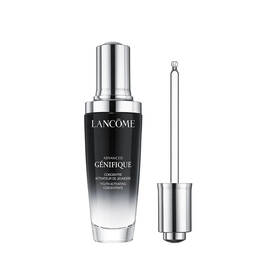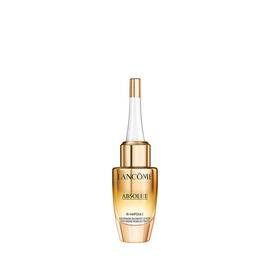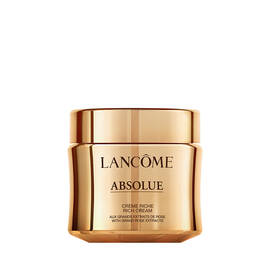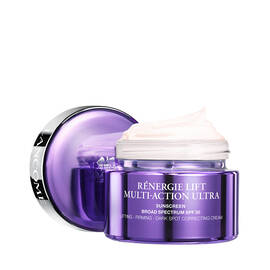Dry Vs Dehydrated Skin: What’s the Difference?
Understand the differences between dehydrated skin and dry skin and learn which Lancôme products can help.

While dry skin is a common catch-all for a range of potential skin concerns, such as rough texture, dull skin, crepey skin, or all of the above, there could be another culprit: dehydrated skin. And no, dehydrated skin and dry skin can’t be used interchangeably, as commonly happens, because they’re actually two separate things. Here, we break it down for you.
What Is Dry Skin?
Dry skin describes skin that lacks oil.1 It’s also a skin type, with genetics being a major factor; so, just as you may have naturally oily skin, you could have been born with dry skin. And because skin doesn’t produce enough oil — an important component of a healthy skin moisture barrier — that can impair its function and lead to tight, rough, or itchy skin. Age can also contribute to dry skin, as well as external factors like harsh weather, UV exposure and extreme changes in temperature.
What Is Dehydrated Skin?
Dehydrated skin, on the other hand, lacks water. It’s also a condition, meaning it can happen no matter what your skin type is. It ultimately occurs if your skin loses water faster than it receives water.2 The big point of difference here is that dehydrated skin isn’t a measure of the oil in skin — meaning it’s entirely possible to have oily dehydrated skin, or even acne with dehydrated skin.
Dehydrated skin can be caused by not properly hydrating as well as anything that compromises the skin barrier, as the skin barrier is integral in preventing trans-epidermal water loss, a process through which water from the skin is evaporated into the air.3 That includes overwashing skin, which can strip skin of moisture, and not moisturizing well or frequently enough. This may seem counterintuitive if you have oily dehydrated skin — but removing too much oil may actually cause your skin to overproduce oil.
How to Tell a Difference between Dry and Dehydrated Skin
If you can’t tell whether you have dry or dehydrated skin, trust us: You’re not alone. Dry skin tends to be flaky or itchy, and may be accompanied by inflammatory conditions like eczema and atopic dermatitis. With dehydrated skin, on the other hand, skin may feel tight, appear dull or have a more wrinkled appearance. Try doing a pinch test, a.k.a. a skin turgor test, to test for it.4 How to do it:
- Pinch your skin with two fingers
- Release the pinched skin
- Judge how long it takes your skin to return to normal
If your skin snapped back pretty quickly, it’s probably not dehydrated. But if it does take longer for skin to return to the state it was before you did the pinch test— think any more than an instant — dehydrated skin may be the cause as low skin turgor, a measure of elasticity, is a sign of dehydration.
How to Help Address the Appearance of Dry and Dehydrated Skin
If your skin is dehydrated, drinking water and upping your overall hydration is a good first step.5 Introducing humectants are also suggested, as these help to draw water into the skin’s surface and help retain it. One of the best-known humectants is hyaluronic acid, as is glycerin. They’re well paired with occlusive ingredients, like oils, to keep water from evaporating from skin’s surface.6
Not surprisingly, a hydrated skin barrier is key here. Dry skin can impair the skin barrier, and an impaired skin barrier can lead to trans-epidermal water loss and thus, dehydration. (If you’re wondering: Yes, it’s possible to have both dry and dehydrated skin.) So, if you notice signs of either, it’s helpful to hydrate your skin barrier. First, don’t cleanse too frequently or with harsh formulas. Then, seek out hydrating formulas that help to fortify the skin barrier with moisture. Consider Advanced Génifique Face Serum, which is formulated with both ceramides and hyaluronic acid, as well as the upcoming Absolue Bi-Ampoule Serum Treatment, which offers overnight repair with a blend of active ingredients, including ceramides, hyaluronic acid and plant oils.
If you have a dry skin type, you’ll have to maintain it long-term with moisturizers that help to provide what dry skin lacks — mainly, those lipids that are so integral to the skin barrier. Consider using products that contain ceramides, which are naturally found in a healthy skin barrier and serve as the “mortar” to the skin cells, which are the “bricks.”
Also, give skin lasting moisture with a moisturizer like Absolue Revitalizing & Brightening Rich Cream, which delivers 24-hour hydration along with firmness and radiance. Infused with Grand Rose Extracts and nourishing plant oils, it supports the skin barrier. For the daytime, try Rénergie Lift Multi-Action Ultra Cream with SPF 30, which contains a unique blend of jojoba, sunflower and mimosa flower waxes. Not only does it provide moisture, but it also offers sun protection.
1 https://my.clevelandclinic.org/health/diseases/16940-dry-skinitchy-skin
2 https://www.mayoclinic.org/healthy-lifestyle/adult-health/expert-answers/hydrated-skin/faq-20058067
4 https://medlineplus.gov/ency/article/003281.htm





